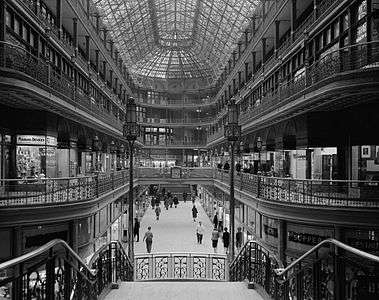John Eisenmann
John Eisenmann (March 26, 1851 – January 6, 1924), was an architect in Cleveland, Ohio. As part of Eisenmann & Smith he designed the Cleveland Arcade in downtown Cleveland. He also designed the Main building for Case School of Applied Science, present-day Case Western Reserve University, where he was also the school's first professor of civil engineering. He pioneered structural steel construction in the United States and is credited with co-designing Cleveland's Arcade, "the first commercial building in the state designated an historic landmark in architecture."[1] Eisenmann is also credited with designing the flag of Ohio in 1902.[2][3]
John Eisenmann | |
|---|---|
| Born | 26 March 1851 |
| Died | 6 January 1924 (aged 72) |
| Nationality | American |
| Alma mater | University of Michigan University of Stuttgart |
| Occupation | Architect |
| Practice | Eisenmann & Smith |
| Buildings | Arcade |
| Design | Flag of Ohio |


Early life
Eisenmann was born March 26, 1851 in Detroit, Michigan to Christian W. and Mary A. (Schubert) Eisenmann. He graduated from Monroe High School in Michigan. In 1871, he graduated from the University of Michigan with a degree in Civil Engineering, and was a member of the Xi Chapter of the Zeta Psi Fraternity.[4] From 1871-1875, Eisenmann worked as an assistant engineer for the United States Lake Survey for the Great Lakes.[5] He then went to Europe to study Architecture, studying first at the Royal School of Technology of Munich, Germany 1875-1876, graduating from the Technical School of Stuttgart, Germany, in 1877.[6] From 1878-1879 he returned working for the United States Lake Survey. From 1879-1882, he then worked for the Mississippi River Commission.
On April 5, 1882, John Eisenmann married Annie M. Theising.
Arcade
The arcade was erected in 1890, at a cost of $867,000.[7] It opened on Memorial Day (May 31, 1890)[7] and is an example of Victorian architecture, consisting of two nine-story buildings joined by a five-story arcade. It includes a glass skylight spanning 300 feet (91 m) along the four balconies.[7]
The arcade is identified as the first indoor shopping mall in the United States.[8] and was built by Detroit Bridge Co., run by Stephen V. Harkness.[7] It is one of the few remaining arcades of its kind in the United States. Modeled after the Galleria Vittorio Emanuele II located in Milan,[7] the Arcade comprises two nine-story towers with a skylight, 100 feet (30 m) high, made of 1,800 panes of glass spanning over 300 feet (91 m). The construction was financed by John D. Rockefeller, Marcus Hanna, Charles F. Brush and several other wealthy Clevelanders of the day.[7] The Arcade was modified in 1939, with remodeling of the Euclid Avenue entrance and some structural supports added.
The Arcade is a cross between a lighted court and a commercial shopping street, composed of three structures: two nine-story office buildings facing out to Euclid and Superior Avenues, connected via the five-story iron-and-glass-enclosed arcade.[7] The Richardsonian arched entrance along Superior Avenue is original but the Euclid Avenue front was remodeled in 1939[7] by the firm of Walker and Weeks.
Vertical lines of the columns rise nearly 100 feet (33 m) to the glass roof and create a spacious domed interior.[7] In 2001, the Hyatt corporation redeveloped the Arcade into Cleveland's first Hyatt Regency hotel. The Hyatt Regency occupies the two towers and the top three floors of the atrium area. The two lower floors of the atrium area remain open to the public with retail merchants and a food court. In addition, the Hyatt's lobby and offices are located near the Superior Avenue entrance.
Projects
.jpg)
- Cleveland Arcade with Eisenmann & Smith
- Case Main Building (1885), Case School of Applied Science in University Circle[10]
- Cinecraft Productions (1898) (Cleveland Public Library West Side Branch - Carnegie System), 2515 Franklin Boulevard in Ohio City.[11][12]
- Esmond Apartment Building (1898), 4806 Euclid Ave.[11][13][14]
- Ohio Building at the 1901 Pan-American Exposition
References
- From a Case Western University website that no longer exists
- http://www.annin.com/products/flag_us_ohio.asp Flags of the Fifty States - Ohio
- "Sarah's Scrapbook". Archived from the original on 2007-01-25. Retrieved 2012-01-10.
- Zeta Psi Fraternity, Xi Chapter (June 1897). Biographical Catalogue of the Xi Chapter of the Zeta Psi Fraternity at the University of Michigan, Ann Arbor, Michigan. 1858-1897 (Speech). Washington, D.C. – via Google Books.
- https://case.edu/ech/articles/e/eisenmann-john
- http://planning.city.cleveland.oh.us/landmark/arch/pdf/archdetailPrint.php?afil=&archID=75
- Arcade, Encyclopedia of Cleveland History, Case Western Reserve University, 10 July 1997.
- "Cleveland+ Public Art" (PDF). Positively Cleveland. 2008. p. 3. Archived from the original (brochure) on 2008-05-17. Retrieved 2009-05-18.
- Eisenmann, John (1901). "The Ohio State Flag" – via Ohio Memory.
- https://case.edu/its/archives/Buildings/casmai.htm
- Designated Cleveland landmarks Cleveland Planning Commission City of Cleveland
- Cinecraft Building Archived 2011-07-16 at the Wayback Machine (includes photo) City of Cleveland Planning
- (includes photo) City of Cleveland Planning Archived 2011-07-16 at the Wayback Machine
- Cleveland landmarks list Archived 2009-07-02 at the Wayback Machine City of Cleveland Planning